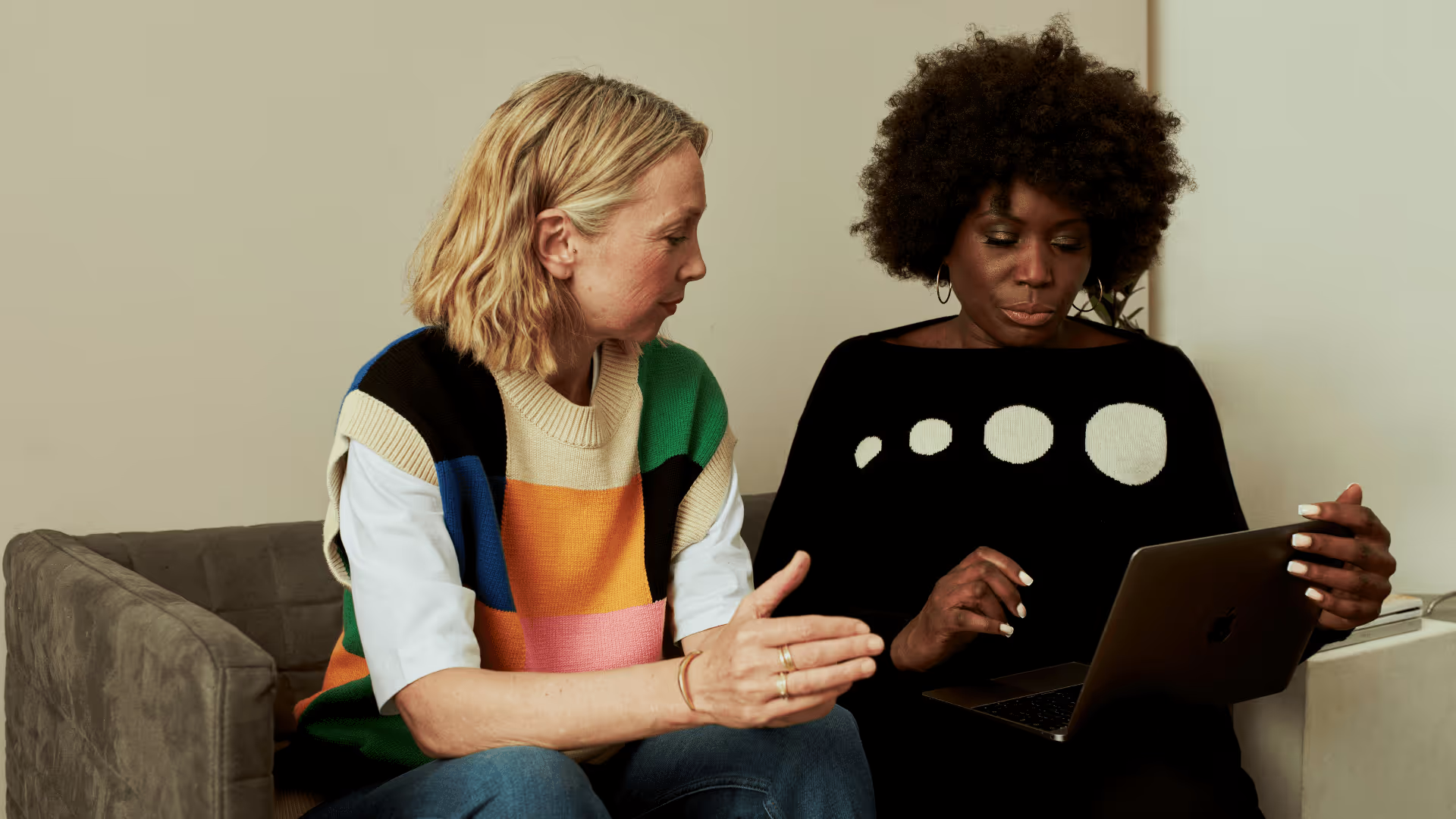5 Steps to Move Your Brand from DTC to Wholesale Success
Discover the essential measures brands moving from DTC to wholesale must consider if they want to achieve retail success, including identifying a solid growth strategy, understanding wholesale pricing and creating high-quality line sheets.
.avif)
Brief Summary
Making the jump from DTC to wholesale requires strategic planning and process adjustments. By digitalizing processes and focusing on durable, strategic wholesale relationships, DTC brands can sustainably scale and diversify their distribution channels. This article outlines five practical steps, from mindset shifts to tactical outreach that helps brands scale effectively into retail partnerships.
Five Key Steps:
- Define Your Wholesale Strategy
Clarify goals, margins, and HDQ product offerings—then create exclusives for wholesale to appeal to different retailers. - Price for Profitability
Understand retail buyer expectations, account for wholesale discounts, and maintain margins by smart pricing and cost structure planning. - Prepare High‑Quality Line Sheets
Invest in polished digital linesheets with clear imagery, pricing, product details, and brand narrative to support streamlined wholesale sales. - Target the Right Retailers
Research buyers aligned with your brand, tailor outreach, and use platforms like JOOR Discover to efficiently connect with vetted retailers. - Build Lasting Relationships
Focus on repeat business—not one-off orders—by offering personalized service, maintaining digitized workflows, and nurturing ongoing partnerships.
Are Brands Activitly Looking to Switch from DTC to Wholesale?
Wholesale's potential is still untapped by so many brands, but with the channel going from strength to strength, now's the time to take advantage of these top tips.
Several of the most successful Direct-to-Consumer (DTC) brands including Fabletics, Bandier and Warby Parker have already made the move into the wholesale space. This trend looks set to continue to grow in the coming years as more DTC brands realize the potential of shifting to wholesale.
Why Successful Brands are Moving from DTC to Wholesale

Wholesale not only builds brand awareness, drives new customer acquisition and increases sales volume through more points of distribution, but it's also cost-effective. For a long time, many held the belief that DTC was a more profitable business model as a brand retains a much higher margin. However, the reality is that a DTC-only distribution model means brands are also burdened with all of the costs related to finding and converting new customers, operating retail stores, and shouldering high shipping and return fees.
These factors often make the company less profitable than if it were leveraging wholesale partners to tackle these expenses. But as more and more DTC brands come to this realization, it makes sense that an interest in wholesale is on the rise.
Moving from DTC to wholesale can be extremely fruitful but it requires careful preparation to ensure your company's success and longevity. As the leading b2b wholesale platform, we service 14,000+ brands across 150 countries and have facilitated over $100 billion in wholesale transactions, so there's no one better positioned to create this comprehensive guide. Let us lead you through the five critical steps every brand should take to build a successful wholesale business.
How To Know If Your Brand Is Ready for Wholesale
If you’re thinking of moving into wholesale, be sure to remove any potential roadblocks before they can cause trouble down the line. Issues like supply chain fragility and thin margins that can’t withstand wholesale discounts will need to be addressed before you can proceed further.
There are also telltale signs that your business is ready to take the next step with wholesale. If you’ve got a strong brand identity that customers connect with, stable DTC revenue, a steady flow of repeat customers, and the ability to constantly meet production runs of increasing size, you could be ready to expand into the channel.
Step 1: Define Your Wholesale Growth Strategy
.avif)
Identify Your Wholesale Objectives
The first step in any DTC brand's wholesale journey should be to figure out which kind of retailers you want to attract. How many retailers do you plan on targeting and why? Think not only about where you want to be stocked (both regionally and globally) but why you want to be stocked there. Pick with intention, the bigger the retailers you target the bigger the potential growth opportunities, but is your brand ready for that?
Are you looking for quick wins or do you want to build a slow but steady retail partnership that can grow with you? Remember that traditional wholesale will stick to an annual schedule, there will be sales cycles and payout dates set by retailers, which can feel like quite a shift in pace from DTC. Planning ahead with a solid strategy for your brand's growth will ensure this doesn't catch you unprepared.
Understand Market Opportunities
Next, you should conduct market research into your competitors. Ask your DTC customers about other brands they like to shop for and investigate the other brands that will be vying for retailers’ attention.
To put yourself at a big advantage, use JOOR’s proprietary retailer directory to see which other brands are being carried by retailers you want to target. Find out what their wholesale prices are and see where you fit alongside them.
What do they offer that's similar to you? And what is your point of difference? Knowing the market landscape inside out will make it easier to identify areas in which your products will stand out and fill a unique need for retailers.
Figure Out Your Wholesale Pricing
For the final stage of step one, set aside time to establish your pricing for wholesale that allows for profitability, while still being attractive to potential retail partners. This will often involve determining what price points are most attractive to your wholesale customer and adjusting your pricing to meet both the retailer and end consumer’s desired price point.
If you're using JOOR, take advantage of the Snapshot dashboard, which gives you access to essential data points and performance metrics in easy-to-read charts and graphs right on your homepage, showing you in real-time what price points are performing best.
Align Wholesale Goals with DTC strategy
Decide whether you’ll use wholesale to expand your reach by entering new regions and markets, or focus the channel on deepening your brand equity by targeting curated boutiques and concept stores. Either way, take careful consideration to avoid creating conflict with any of your existing channels and ensure that your own DTC prices are not undercut at any point.
Step 2: Develop Your Wholesale Product Offering
.avif)
Adjust Your Assortment
Once you've worked out a wholesale strategy, it's time to think about how you will captivate potential buyers. Choose which products you want to offer to wholesale partners and adjust your assortments accordingly.
Decide if you want to create any exclusive styles or colorways for this new channel or for certain particular partners. Many brands design exclusive products to cater to retailer demands, providing them with a style that isn’t available anywhere else, and this can often make your brand more appealing to potential buyers.
Create Your Line Sheets
When your assortment is confirmed, create line sheets with high-quality images and clear descriptions to showcase what makes your brand unique and desirable to potential wholesale clients. Organizing your products logically will streamline the browsing experience, making it easier for buyers to find what they're looking for.
Be sure to specify available sizes, color variations, and delivery windows to streamline the ordering process. If applicable, you might also want to consider showcasing sustainable materials and/or manufacturing practices - something that a growing number of retailers look for as customers seek out more eco-conscious fashion choices.
Define Minimum Order Quantities
In order to operate a profitable business brands often require minimum order quantities - meaning a certain number of units need to be ordered to put a style into production. Work out and clearly communicate the minimum number of units per style or color that a retailer must purchase in a single order and confirm the lead times necessary to accommodate wholesale orders.
Remember unlike an online DTC store, retailers need to psychically present a collection of your products to customers in store, and so they will require a range of products in the right quantities to look attractive on the shop floor.
Create Exclusive or Limited Wholesale Products
Customers value products they can’t find anywhere else, which means retailers are always looking for brands that are willing to create in-store exclusives. Limited edition wholesale products can be beneficial for both brands and buyers, as they drive customers in-store with urgency to secure the product before it sells out, while protecting a DTC brand’s channel.
Step 3: Build Your Wholesale Infrastructure
.avif)
Hire a Dedicated Wholesale Sales Representative
While you may already have a strong team at your DTC brand, it is worth hiring a dedicated wholesale sales team or at the very least one independent wholesale representative. Investing in talent that has a wealth of experience in the channel will be beneficial as they will already know how the sales cycle works and will be able to best advise you on how to establish and maintain buyer relationships.
If you’re not quite ready to hire a dedicated team member in-house, consider working with a showroom that will represent your brand as another option to start building your wholesale business.
Create Wholesale Contracts
Develop a formal agreement that outlines terms and conditions for retailers. This will be a critical tool to ensure there is a common understanding of expectations when retailers place an order and will eliminate miscommunication. This contract should include but is not limited to payment terms, shipping logistics, return policies, and exclusivity agreements if applicable.
Upgrade Your Order Management Tools
Before moving from DTC to wholesale it's key that you upgrade your order management system so that it can handle new wholesale orders. A B2B portal like JOOR can act as a centralized platform, so you can not only identify and connect with retailers, but also track orders, communicate changes, monitor live insights, manage returns, and process payments from various buyers efficiently.
In turn, retailers can easily place orders, find product information, access imagery and read promotional materials from your brand.
Manage Cash Flow & Retailer Payment Terms
Remember, when expanding into wholesale, you must have enough working capital to cover your production before you receive payment from clients. If you predict that your cash flow will be tight, look into trade finance or invoice factoring and consider if these could be options for your DTC business.
Invest in Compliance & Certifications
As consumer demand for transparency grows, retailers are increasingly requesting certifications such as GOTS and OEKO-TEX®. By investing in compliance, you can gain access to premium buyers and larger stockists, leading to more sales and faster growth for your brand.
Step 4: Identify and Connect with Target Partners

Research Relevant Stores
Identify the kind of retailers you think your brand would be best suited to. Remember department stores with multiple locations offer worldwide appeal and can put your products in front of a huge audience, but specialist independent boutiques that cater to a select but highly curated clientele can help your brand build a loyal following.
To simplify this step we created the Find New Retailers feature on JOOR. The functionality makes it easy to identify potential buyers that align with your business goals and the advanced algorithms behind the search engine help you get the best matches possible.
Filter retailers by location to find boutiques where you want to expand your presence, or search select product categories and focus on retailers specializing in your areas to increase the chances of a successful partnership.
Identify and Reach Out to Contacts
Once you have found retailers that you think could be a good match, the next step is to try and initiate contact. You can usually use email or social media to reach out and begin to establish new connections, but this will require a lot of research and can easily eat away at precious business time.
If you are using JOOR, you can easily view a retailer’s profile to find their key contact information and send a connection request so you can start building meaningful business relationships in seconds.
Leverage DTC Data to Target Wholesale Markets
For the best chance at wholesale success, leverage the customer shipping data from your DTC brand to help identify hotspots and regions where there is a large demand for your products. You should also take time to track your product-level performance; this way, you can easily pitch top sellers to retailers.
Attend Trade Shows & Industry Events
Trade shows are a great opportunity to meet buyers, showcase your new collections and test out your new positioning. You can get a real-time feel for how retailers respond to your products and make changes based on the feedback you receive.
If you can’t attend events in person due to regional or financial restraints, consider digital trade shows such as JOOR Passport. These give you access to some of the world’s most sought-after retailers from the comfort of your own office.
Step 5: Market Your Brand to Retailers
.avif)
Define Your Proof Points
Now that you've engaged your target retailers, it's time to think about what will make your brand appealing to them besides your products. Gather any impressive statistics about your brand that you can.
Do you have a strong social media presence? Have you won any awards of note? Are there any news articles about your business that are particularly impressive? It's imperative that you create a bank of this information to keep in your wholesale arsenal. Looking at the information and data you have gathered, what is the brand story that you can tell potential stockists that will get them wanting to carry your products?
Create Marketing Materials
Lookbooks are a great way to tell your brand story and also highlight the breadth of your collections. These can be circulated at industry trade shows, fashion markets, or in physical showrooms and are an effective way to convey your brand ethos, seasonal inspiration, and key product highlights to generate interest from buyers.
Support Retailers with Co-Marketing
There are many ways you can support retailers when marketing g your products. From joint social media posts to special in-store pop-ups and press features, think about the kinds of collaborations that could benefit both of your businesses.
To make things easy for retailers, provide promotional kits that include product images, POS materials and influencer tie-ins, so they can identify quick and easy marketing wins. Remember, co-marketing means retailers are more likely to sell through faster and re-order more from you, so it’s an important aspect to consider.
Wholesale Risk & Financial Planning
When moving into wholesale, there are several challenges you may face, especially if you are unprepared, including delayed payments, overproduction issues and retail dependence.
Try to take action to prepare for this by diversifying your wholesale partners, maintaining your DTC channel as a fallback and negotiating payment terms ahead of wholesale deals wherever possible.
JOOR Makes Marketing to Retailers Easy
As the industry-leading wholesale platform, we've made it easier than ever before for brands to market to new buyers. Consider your brand Profile on JOOR as the homepage of your own B2B website. It is completely customizable and designed to showcase your brand and product in the most dynamic way possible.
This virtual showroom for your brand allows buyers around the world to browse at their convenience. With capabilities for high-res 360° images, shoppable lookbooks and engaging videos, you can create a truly immersive experience they're sure to remember.
Follow these five comprehensive steps and you will be well on your way to wholesale success. If you feel like you need a helping hand streamlining your DTC brand's transition to this new channel, consider joining JOOR today.
Increase Brand Awareness by Utilizing Wholesale
You can also increase your brand’s visibility to buyers by booking JOOR’s Retail Centre Banner, an advertising placement which features your brand right on the retailer login screen to grab busy buyers’ attention, and by participating in JOOR Passport events - our curated digital trade shows.
These digital showcases are designed to help retailers discover new brands like yours without having to step out of their office. We run a variety of different themed events throughout the year in line with the fashion calendar, and with a single JOOR login buyers can browse the shows and connect with brands like yours.
Book a demo to see how we can help you tackle the next chapter in your retail business and show you how easy it can be to transform your brand with the endless possibilities (and profitability) that wholesale can bring.
Conclusion
While the topic of conversation is often ‘direct to consumer vs wholesale’, smart DTC brands know that expanding into wholesale can complement their business, helping to increase revenue, which can then be put back into driving the business further.
Brands interested in expanding into the channel should prepare their strategy, pricing and linesheets, and learn how to find the right retailers and build lasting relationships for the best chance at success.
FAQs on Moving From DTC to Wholesale
When is the right time to move from DTC to wholesale?
DTC brands should move into the wholesale channel once they have built a strong brand identity, have stable revenue, a steady flow of repeat customers, and the ability to constantly meet production runs of increasing size.
What’s the main difference between DTC and wholesale pricing?
Wholesale pricing gives you a lower profit margin on each product compared to if you were selling it via DTC; however, wholesalers usually buy in large quantities, meaning you have the potential to receive larger orders, leading to a much bigger increase in revenue.
How do I avoid competing with my own DTC channel?
When moving from DTC to wholesale, ensure that your own DTC prices are not undercut at any point by your retail partners. Offering retailers exclusive or limited edition products can also combat direct competition with your DTC offering.
What role does technology play in wholesale expansion?
DTC brands can use tech tools, including wholesale management software, real-time inventory updates and built-in integrations to unify their workflow, saving time, reducing errors and helping to fuel expansion.
Do small DTC brands benefit from wholesale, or is it only for large brands?
Both large and small DTC brands can benefit from wholesale. JOOR offers three different payment plans depending on the size of your company, making the channel accessible to all kinds of businesses.

Discover the Top 5 Trends in Wholesale for 2025
Related Insights

Why Digital B2B Catalogs are Essential for E-Commerce Businesses
Online catalogs have become a crucial component for retailers and their buyers in an evermore tech reliant industry. Read about how these dynamic product libraries act as comprehensive selling solutions that plug into current buying behaviors.
%2520(2)%2520(1).avif)
8 Ways a B2B Fashion Marketplace Solves Wholesale Scaling Challenges
Learn how a B2B fashion marketplace like JOOR helps your wholesale fashion brand overcome scaling challenges. Maximize resources, build retailer relationships, and enhance distribution to drive growth in the global wholesale fashion market.
%2520(1).avif)
Price Sheets Vs Line Sheets in Wholesale Fashion
Explore the key differences between price sheets and line sheets in wholesale fashion. Optimize product showcasing and sales strategies with clear pricing details and captivating visuals. Enhance buyer experience and streamline ordering process effectively.
%2520(2)%2520(1).avif)
8 Ways a B2B Fashion Marketplace Solves Wholesale Scaling Challenges
Learn how a B2B fashion marketplace like JOOR helps your wholesale fashion brand overcome scaling challenges. Maximize resources, build retailer relationships, and enhance distribution to drive growth in the global wholesale fashion market.
.avif)
Choosing the Right Wholesale Fashion Platform: Key Factors to Consider
Now is the time to maximize your business strategy by digitalizing your wholesale process. Here’s your 4-point checklist for choosing the right digital platform and key features to consider when searching for your best B2B digital wholesale solution.


.avif)
.avif)